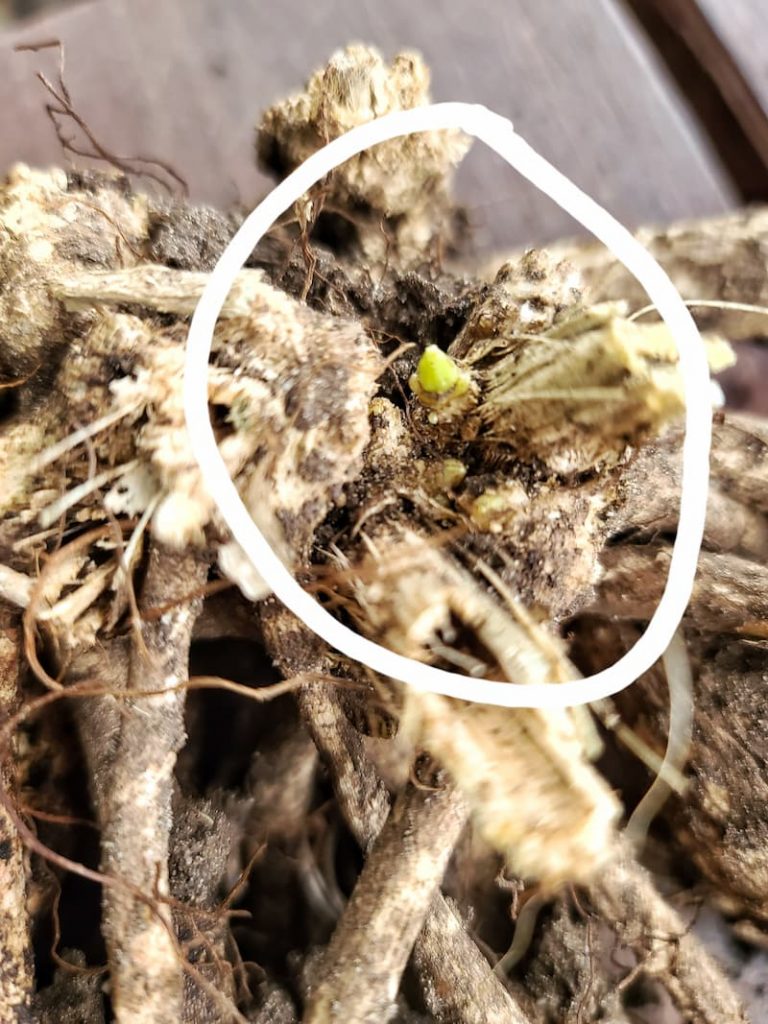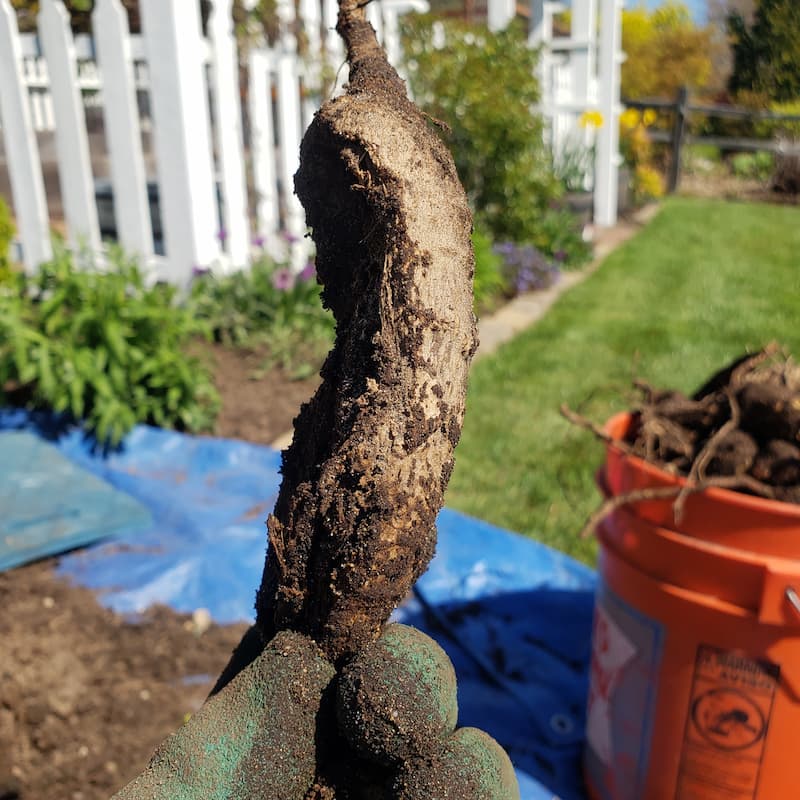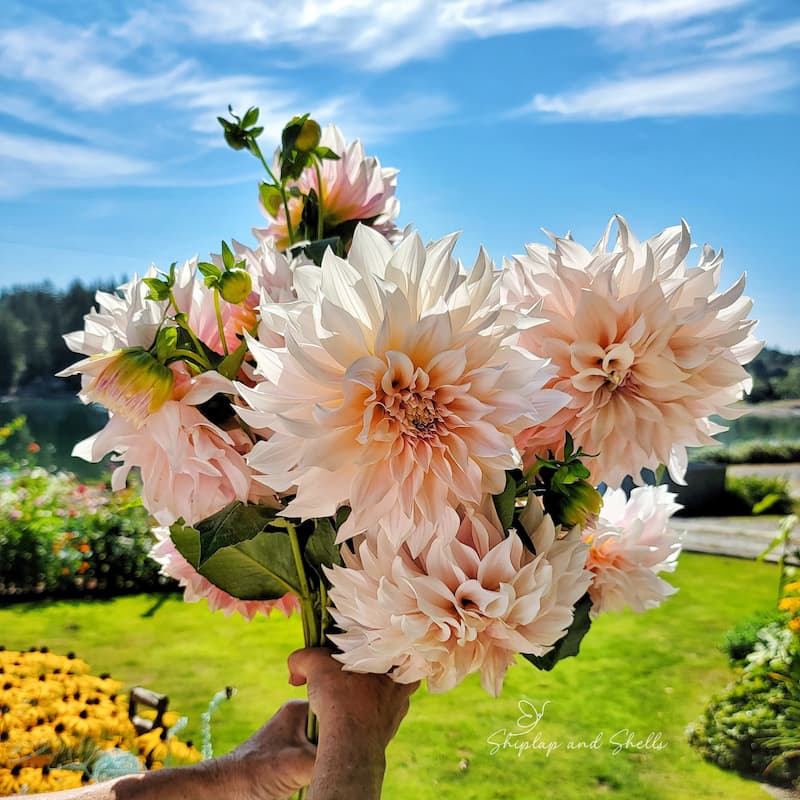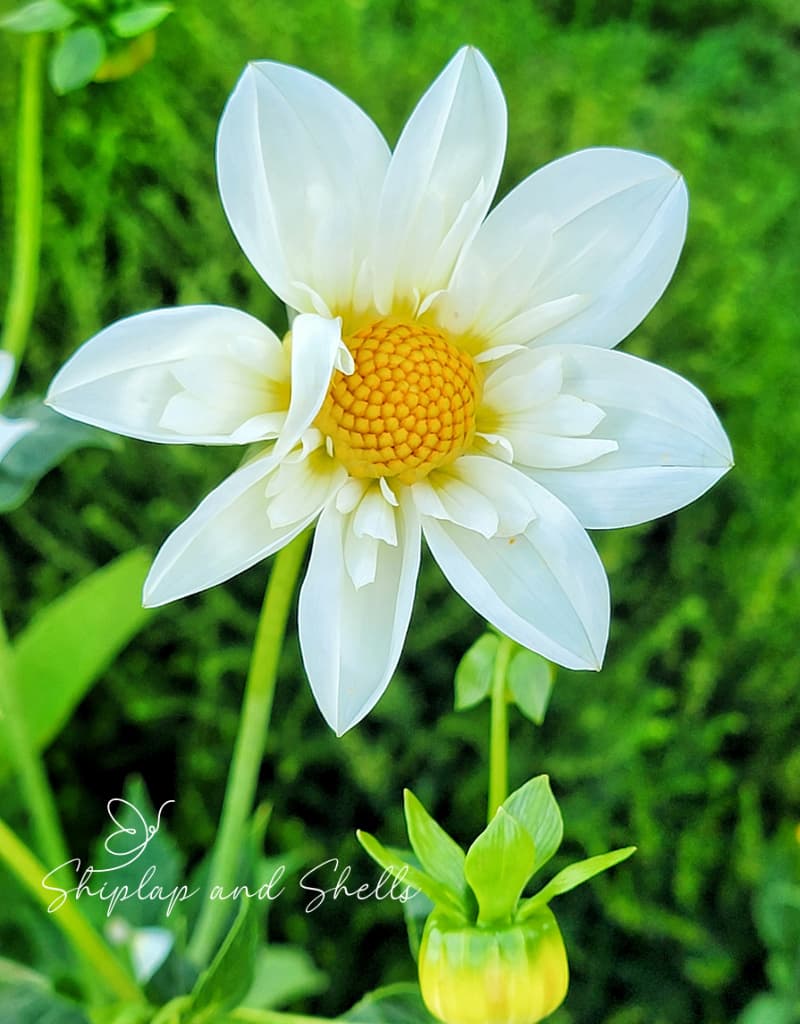Did you know that dividing your dahlia tubers every year has many benefits? I’ll show you my process for dividing dahlia tubers in the spring and explain the advantages of splitting these dahlia root clumps annually.
Dividing your dahlia bulbs every year is essential to get the most beautiful flowers and best results from your dahlia plants next year.
Dahlias are one of my favorite cut flowers in the garden. So many different varieties offer the most vibrant colors and unique shapes and sizes.
They may be late bloomers, but once they do, your dahlias will be the last flower in your garden until the first hard frost.
As an Amazon affiliate, I earn from qualifying purchases at no extra cost to you. My blog contains other affiliate links for your convenience as well. Click here to read my privacy policy.
Separating Dahlia Tubers in Spring: A Step-by-Step Guide
Dahlias are stunning flowers that come in a dazzling array of colors, shapes, and sizes. These tuberous plants produce more tubers each year, making dividing dahlia tubers a great way to get more plants from your existing collection. Separating the tubers in spring also helps maintain their health and vigor
When is the Best Time to Divide Dahlia Tubers?
The ideal time to divide dahlia tubers is in early spring just as the new shoots begin to emerge from the tubers. This is usually around mid to late spring, depending on your growing zone and dahlia variety. Separating the tubers too early or late can negatively impact their ability to establish and grow properly.
Step-by-Step Guide to Separating Dahlia Tubers in Spring
Follow these simple steps for successfully dividing dahlia tubers in spring:
Supplies Needed
- Garden fork or shovel
- Sharp, clean knife or pruners
- Plastic containers or trays
- Potting mix or vermiculite
- Fungicide powder (optional)
-
Dig Up the Dahlia Tubers
Carefully dig up the entire dahlia clump using a garden fork, being careful not to damage the tubers. -
Remove Excess Soil
Gently shake or brush off any loose soil, taking care not to wash off the tubers as excess moisture can cause rotting. -
Inspect and Discard Unhealthy Tubers
Look for tubers that are damaged, diseased, or rotting. Discard any unhealthy tubers to prevent disease spread. -
Divide the Clump
Separate the clump into smaller sections, making sure each division has at least 1-2 strong growth eyes. A sharp, clean knife works best. -
Dust with Fungicide
Lightly dust cut surfaces with a fungicide powder to prevent rot and diseases in the fresh wounds. -
Allow Divisions to Dry
Let the divided tubers dry out for 1-2 days. This helps seal wounds and prevents rot issues. -
Label the Divisions
Label each division by color or variety for easy identification later on. -
Store or Replant
Store the dormant tubers or replant them immediately in rich, well-draining soil in a sunny spot.
Caring for Newly Divided Dahlia Tubers
Proper care after dividing dahlia tubers helps ensure their health and productivity:
-
Plant in nutrient-rich, well-draining soil. Amend with compost if needed.
-
Space the tubers 18-24 inches apart to prevent overcrowding.
-
Water immediately after planting and keep soil moist but not saturated.
-
Apply balanced fertilizer when sprouts appear. Follow label instructions.
-
Install stakes or cages for support as the plants grow taller.
-
Monitor for pests like slugs, snails, and earwigs and treat promptly.
-
Deadhead spent blooms to encourage more flowers.
-
Mulch around plants to retain moisture and suppress weeds.
-
In fall, dig up tubers again before first frost and store over winter.
Tips for Successful Division
-
Wait for the right spring timing when eyes begin to swell.
-
Work quickly to prevent tubers from drying out.
-
Make clean cuts with sterilized tools to avoid disease transmission.
-
Gently handle tubers to prevent breaking the fragile new growth.
-
Leave a few growing eyes on each division. More eyes = more blooms!
-
Plant immediately or store in cool, dry conditions if waiting to plant.
-
Give divided tubers time to establish before summer heat arrives.
With the proper technique and care, separating dahlia tubers is an easy way to expand your garden palette. The divisions will reward you with vigorous growth and masses of gorgeous blooms in the seasons to come.

How to Divide Large Clumps of Dahlia Tubers
Now that the dahlia clumps are out of the ground, gently shake off any excess dirt from the tubers, leaving some dirt to help retain moisture.
Use sharp, clean loppers, pruners, or a knife when cutting your root clumps. Between each clump division, disinfect these tools by dipping them in a bleach/water solution to prevent spreading diseases to the tubers.
Dividing the clumps in half will make them easier to work with. You can also divide the sections even smaller or into individual tubers.
When splitting the tuber clump, you don’t have to try to save the mother tuber since you’ll be cutting it out of the dahlia clump anyway.
The dahlia tuber stem is a source of rot and spreading insects, so remove as much of it as possible. Remove as much of the stem as possible from the dahlia tuber.

Viable tubers must have an eye. Before an eye sprouts from a tuber, it will look more like a tiny bump. Eyes are basically where the stem comes from the following year.

Examine each dahlia tuber to see how they made it through the winter. Cut these tubers out of the root clump:
- The mother tuber because it’s already expended most of its energy. These offshoots usually have white or pink dots around the base of the stem rather than the typical growth eyes.

- Any damaged, rotted, or diseased tubers.
- Tubers that are small or have skinny necks and no eyes.

Dig a hole 4-6 inches deep and lay the tuber horizontally on its side, with the eye facing up. Space the tubers between 12-18 inches. Fill the hole with soil and press down to remove any air bubbles.
Don’t water your newly planted tubers until you see the first green shoots coming up through the ground. Watering before any new growth is visible can cause the tubers to rot.
Consistently water your dahlia plants throughout the growing season. After establishing your dahlias, you should water them deeply 2-3 times a week for at least 30 minutes. I have a drip system that works well.
Slugs and snails LOVE dahlias, so as soon as you see new growth popping out of the ground, you must use some slug prevention. I use Sluggo, which is safe for pets. I can’t tell you how often I have had slugs eat the plant as it was just starting.
For more specific information on growing and caring for dahlias, visit my blog post Dahlia Planting Guide for Beginners.

Dividing Dahlias in the Spring
Consider your last frost date if you’re uncertain when you should divide dahlia bulbs. Information about USDA hardiness zones can be found here.
The best time to divide dahlia tubers is in the early spring or when the risk of a hard frost has passed. This is when the eyes on the tuber are more visible. Sometimes, if the timing is right, you will even see sprouts where the tuber eyes are, making the process much easier.
It’s also a good time to discard any diseased or rotten tubers or diseased tubers that have not survived the winter.

Dividing Dahlias! ✂️ // Garden Answer
FAQ
Can I split dahlia tubers in spring?
Some like to divide their dahlia clumps in the fall after digging and before storage. Personally, I find it more challenging to successfully store tubers after they have been divided. I have had much better success by leaving my clumps whole and dividing them in late winter/ early spring.
What happens if you don’t divide dahlia tubers?
Each plant will produce a clump of new tubers which, undivided, will produce smaller plants with poorer quality blooms.
How do you divide a clump of dahlia tubers?
- Step 1: Clean up all the roots at the end of the tubers and any tubers with broken necks. …
- Step 2: My first split will more or less break the clump in two so I can split it down further. …
- Step 3: Here I am further breaking down the tuber, splitting it in half again.
What to do with dahlia tubers in spring?
-
Check for Eyes:Ensure your dahlia tubers have “eyes” or small bumps where shoots will emerge.
-
Pre-sprouting:If tubers are dormant, place them in a warm, sunny location (like a south-facing window or greenhouse) to encourage sprouting.
-
Potting:Fill pots with peat-free, multi-purpose potting compost and place the tubers with the central stem upwards, covering with more compost.
-
Watering:Water lightly after planting and only when the compost starts to dry out.
-
Warmth:Keep the pots in a warm, frost-free location like a greenhouse or a sunny room.
When is the best time to divide dahlia tubers?
The best time to divide dahlia tubers in spring is when new shoots begin to emerge and the soil has warmed up. This is usually around late March to early April, depending on your climate. How do you divide dahlia tubers in spring? To divide dahlia tubers in spring, start by carefully digging up the dahlia clump with a garden fork.
How do you divide dahlia tubers?
Dividing dahlia tubers involves separating these storage structures into smaller sections, each of which can grow into a new dahlia plant. The best time to divide dahlia tubers in spring is when the plants have started to emerge from the ground, but before the new shoots have grown too large.
How to propagate dahlia plants?
One of the best ways to propagate dahlia plants is by dividing their tubers. Dividing dahlia tubers not only allows you to create more plants from a single parent plant, but it also helps in maintaining the health and vigor of the existing plants.
Should you leave dahlia tubers in the ground?
Separating healthy tubers from diseased or damaged ones will also ensure vital plants for the next season. The tubers you grew this season will become many more plants the following spring and summer. Dahlia growers know better than to take a chance and leave the tubers in the ground over winter.
Should you divide a dahlia plant?
If you have a large dahlia plant that takes up too much space in your garden, you can separate the tubers to create smaller plants. As dahlia plants age, they can become less productive and less vigorous. Dividing dahlia tubers can help renew older plants. Splitting and replanting them can rejuvenate the plant and promote new growth.
What happens if a dahlia tuber breaks apart?
If it breaks apart, dahlia tubers will send up more eyes from where the original broke off. Use a pitchfork or shovel to carefully dig around the large clump and pull up with last year’s stalk if possible. Using a garden fork over a shovel is easier on the dahlia tubers as it causes less damage.
